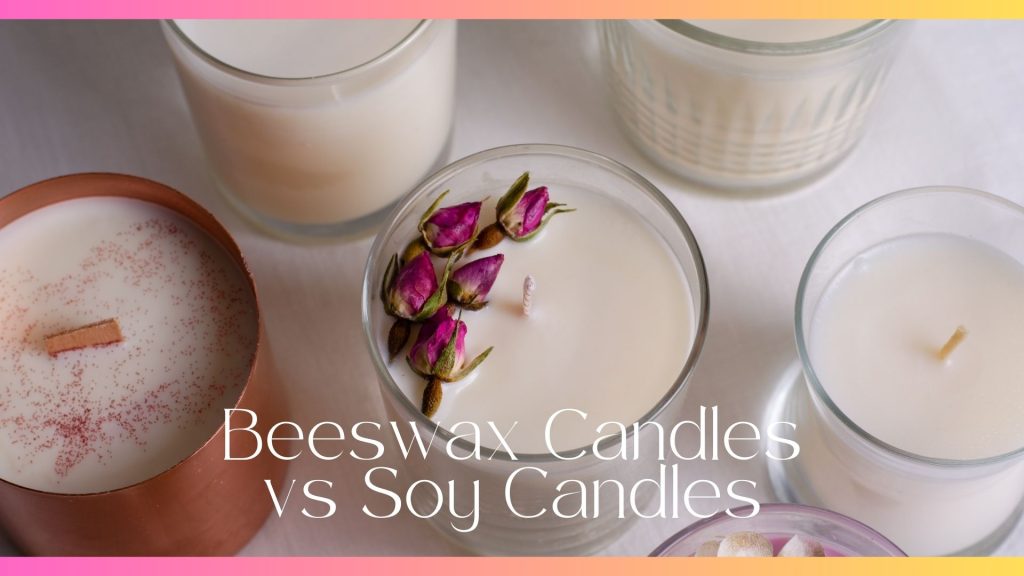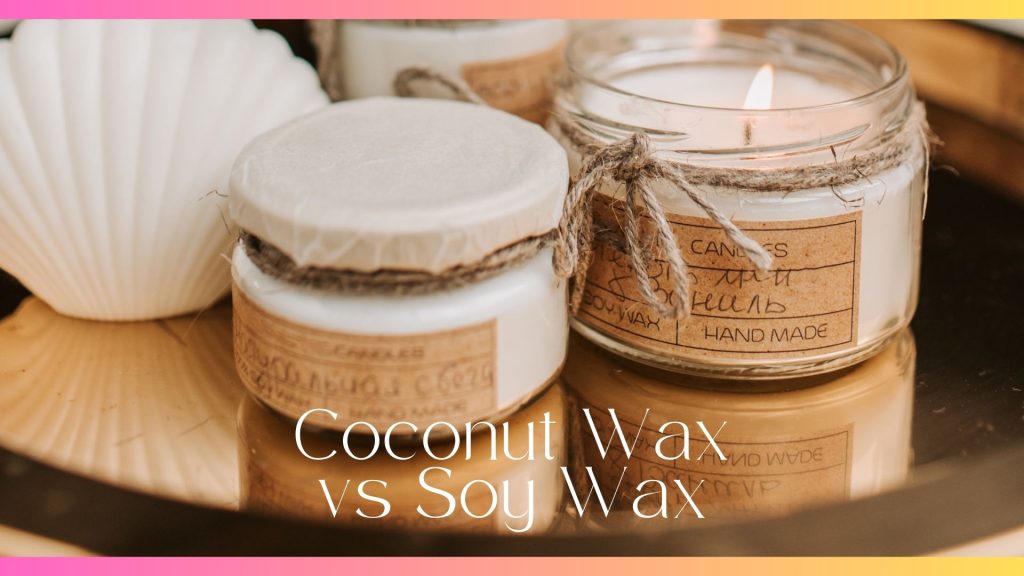Comparing coconut wax vs palm wax for candle-making? Here’s everything you should know before deciding which one is the right one for you.
Some people may confuse between coconut and palm – but if you’re a candle maker, you wouldn’t want to be in that position!
In this article, I’ll discuss the differences between coconut wax and palm wax, including what makes them a good wax option for candle-making.
Disclaimer: This post may contain affiliate links. This means I may earn a small commission (at no cost to you) if you sign up for a program or make a purchase using my link!
Related Posts:
- Soy Candles vs Coconut Candles for Candle-making
- How To Make Coconut Wax Candles with Essential Oils
- How Long Do Coconut Wax Candles Need To Cure?
What is Candle Wax?
Candle wax is a solid material that becomes liquid when heated and re-solidifies when cooled. It’s used to hold a candle’s shape and fuel the flame.
Waxes can be made of synthetic and natural resources, with only a few suitable for candle-making. The type of wax used in candle-making is important as it affects the candle’s burn time and scent throw.
If you’re a candle-maker, knowing the type of candle waxes available to you is crucial for you to make a good choice for your products.
7 Types of Waxes Used for Candle-making
The most common types of candle wax include paraffin wax, soy wax, beeswax, coconut wax, and palm wax. Each type has unique characteristics that affect candle performance, aesthetics, and environmental impact.
1. Paraffin Wax
Paraffin wax, derived from petroleum, is the most widely used wax in candle-making due to its affordability and versatility. It offers excellent scent throw and color retention but produces more soot compared to natural waxes.
2. Soy Wax
Soy wax is made from hydrogenated soybean oil, making it a renewable and biodegradable option. It burns cleanly with minimal soot and is ideal for container candles due to its lower melting point.
3. Beeswax
Beeswax, produced by honeybees, is natural, renewable, and emits a subtle honey scent when burned. It burns cleanly with virtually no soot and is commonly used for tapers, pillars, and molded candles.
4. Coconut Wax
Coconut wax, derived from refined coconut oil, is eco-friendly and biodegradable. It burns cleanly with a strong scent throw and has a smooth, creamy texture ideal for container candles.
5. Palm Wax
Palm wax is made from palm oil and is known for its renewable properties but is associated with deforestation concerns. It burns cleanly and creates unique crystalline patterns in candles.
6. Gel Wax
Gel wax, made from mineral oil and polymer resin, is transparent and flexible, allowing for novelty candles with embedded items. It burns longer than paraffin wax and is used for decorative purposes.
7. Rapeseed Wax
Rapeseed wax, derived from rapeseed (canola) oil, is renewable and biodegradable. It burns cleanly with minimal soot and is suitable for various candle types.
What is Coconut Wax?
Coconut wax is made by hydrogenating coconut oil. The demand for coconut wax is growing in today’s candle industry as it is natural and a renewable resource. This makes it an eco-friendly choice for candle-makers and some particularly prefer it over soy wax as it has a smooth texture and an excellent scent throw.
Benefits of Coconut Wax
- Eco-friendly: Coconut wax is a sustainable option.
- Excellent scent throw: It disperses fragrance well throughout a room.
- Long burn time: Coconut wax candles last longer than many other types.
- Smooth texture: It has a creamy appearance that adds a touch of luxury.
Drawbacks of Coconut Wax
- Cost: Coconut wax is more expensive than other waxes.
- Availability: It’s less widely available compared to other wax types.
- Lower melting point: It has a lower melting point, which may not be ideal for warmer climates.
What is Palm Wax?
Palm wax is made from the hydrogenation of palm oil. Similar to coconut wax, palm wax is another natural and renewable resource that is often used in candle-making for its distinctive aesthetic. Its unique crystalline texture and hardness can be advantageous!
Benefits of Palm Wax
- Eco-friendly: When sourced sustainably, it’s an eco-friendly option.
- Unique texture: It has a crystalline structure that gives candles a unique look.
- Hardness: Palm wax candles are durable and hold their shape well.
- Burn time: Offers a long burn time.
Drawbacks of Palm Wax
- Sustainability concerns: Palm oil production can lead to deforestation if not managed responsibly.
- Cost: Palm wax can be expensive, depending on sourcing practices.
- Scent throw: While good, it’s not as strong as coconut wax.
Key Differences Between Coconut Wax & Palm Wax
To make it easier for you, I’ve prepared a table outlining the key differences between coconut wax and palm wax.
These are some things you’ll need to know as someone who plans to use these waxes for candle-making.
| Aspect | Coconut Wax | Palm Wax |
|---|---|---|
| Source | Derived from refined coconut oil | Derived from palm oil |
| Sustainability | Eco-friendly, biodegradable, renewable | Eco-friendly but associated with deforestation and habitat loss |
| Burn Quality | Burns cleanly with minimal soot | Burns cleanly but can produce more soot than coconut wax |
| Scent Throw | Excellent scent throw, holds fragrance well | Good scent throw, but not as strong as coconut wax |
| Texture | Smooth and creamy | Harder, with a crystalline appearance |
| Melting Point | Lower melting point, around 100-110°F (38-43°C) | Higher melting point, around 120-140°F (49-60°C) |
| Candle Burn Time | Long burn time, consistent burn | Long burn time but can vary based on formulation |
| Color | Naturally white, can be colored easily | Naturally white to off-white, can be colored |
| Fragrance Compatibility | Compatible with a wide range of fragrance oils and essential oils | Compatible with fragrance oils, but essential oils may vary |
| Environmental Impact | Low impact, supports sustainable agriculture | Higher impact, concerns over palm oil production practices |
| Use in Candle Making | Ideal for container candles, smooth finish | Ideal for pillar and votive candles, creates unique patterns |
| Availability | Growing in popularity, becoming more widely available | Widely available but with ethical sourcing concerns |
| Cost | Generally higher due to production processes | Typically lower cost, but varies based on sourcing practices |
In summary, both waxes are sustainable and eco-friendly. There are questions on the sustainability of palm wax due to farming practices which may involve deforestation and habitat destruction.
When used for candle-making, both coconut wax and palm wax are non-toxic, burns cleanly without releasing harmful chemicals and releases very little soot. This makes them safer options for indoor use, particularly for those with respiratory issues or sensitivities.
It’s important to note that palm wax produces slightly more soot than coconut wax.
If you’re concerned about your candle’s performance, coconut wax candles have a longer burn time compared to palm wax candles. Good thing is, both types burn evenly which reduces the occurrence of tunneling.
Coconut wax also has stronger scent throw compared to palm wax, dispersing fragrance well throughout a room. This makes coconut wax a better option if you’re making highly fragrant candles.
It can be quite tricky to compare prices as it depends largely on the availability of wax in your country. However, coconut wax is known to be more expensive than many other types of wax due to its high-quality and sustainable sourcing.
Coconut Wax vs Palm Wax vs Soy Wax
Soy wax is another renewable and environmentally friendly option that is made from hydrogenated soybean oil. It burns cleanly, produces minimal soot, and has a long burn time compared to traditional paraffin candles.
If you’re a complete beginner in candle-making, working with soy wax can be easier due to its lower melting point. It is also cheaper than coconut wax and palm wax – and can be found easily both online and offline.
The only drawback is that soy wax may not hold fragrance as well as coconut wax or palm wax for that matter. Similar to the concerns we have about the production of palm wax, soy wax may also involve intensive farming practices that may not make it a sustainable alternative.
Palm Wax vs Soy Wax vs Beeswax
Beeswax is another wax alternative that’s gaining popularity among eco-conscious consumers. It is a natural byproduct of honey production and is highly regarded for its air-purifying properties. Negative ions are emitted when a beeswax candle is burned which helps with reducing indoor pollutants.
It is more expensive to source beeswax but you may love it for their longer burn time and pleasant natural scent. It’s less ideal to be used for making dyed candles as it already has a natural golden color. Some may not prefer beeswax candles against soy or palm wax candles as it is not vegan.
Read: Beeswax Candles vs Soy Wax Candles: What You Should Know
Best Candle Wax for Beginners
Like I’ve explained above, soy wax is generally recommended for beginners in candle-making as it is easy to use and highly versatile. The lower melting point simplifies the melting and pouring process.
When made into candles, soy wax burns cleanly with minimal soot and is ideal for indoor use. You can also experiment with various fragrances and color dyes to make your candles more unique without much difficulty.
It’s easier for you to source soy wax as they’re widely available and affordable. Although other waxes like coconut wax and beeswax offer unique benefits, soy wax provides a balanced combination of ease, performance, and cost-effectiveness, making it the best candle wax for beginners.
Bottom Line
Both coconut wax and palm wax have their own sets of benefits and drawbacks. Coconut wax is excellent for those who prioritize eco-friendliness and a strong scent throw, while palm wax is perfect for those who love unique textures and sustainable options.
If you’re a candle-maker looking to sell candles, it’s best to test out these waxes with your favorite fragrances to see if there’s demand and if you like them yourself.
Frequently Asked Questions (FAQs)
Palm wax is a popular choice in the candle-making world due to its unique characteristics and sustainability aspects. One of the key benefits of palm wax is its ability to create a crystalline or feathered effect on the candle surface, adding a visually appealing touch. However, the sustainability of palm wax largely depends on the sourcing of the palm oil. Unsustainable palm oil plantations can lead to deforestation and habitat destruction, which is a significant drawback. Palm wax may also be more challenging to work with compared to other waxes due to its higher melting point. Therefore, whether palm wax is better depends on individual preferences and the importance placed on environmental considerations and ease of use.
Coconut wax, while highly regarded for its eco-friendly properties and excellent scent throw, does have some disadvantages. One notable drawback is its cost. Coconut wax tends to be more expensive than other types of wax, such as paraffin or soy, due to the higher costs associated with its production and sourcing. Additionally, coconut wax is softer than many other waxes, which can pose challenges in hotter climates as it may not hold up as well in higher temperatures. This softness can also affect the structural integrity of the candle, requiring careful blending with harder waxes to achieve the desired firmness.
When it comes to choosing the healthiest wax for candle making, soy wax often stands out as a top contender. Soy wax is made from hydrogenated soybean oil, a renewable resource that burns cleanly and produces minimal soot. This reduces the risk of indoor air pollution, making it a healthier option for both people and pets. Soy wax is also free from harmful chemicals and additives, which are sometimes found in other wax types like paraffin. Additionally, soy wax has a lower melting point, which allows it to burn cooler and longer, further minimizing the release of potential toxins. While there are other healthy wax options such as beeswax and coconut wax, soy wax strikes a good balance between health benefits, affordability, and availability.
Coconut wax is often hailed as one of the best waxes for candle making, thanks to its numerous advantages. One of the standout features of coconut wax is its excellent scent throw, both hot and cold, which enhances the aromatic experience of candles. It also burns cleanly and evenly, producing minimal soot and extending the life of the candle. Additionally, coconut wax blends well with other waxes, allowing for versatility in creating different candle types and improving the overall performance of the candle. However, whether it is the best choice depends on individual preferences and priorities. While it excels in many areas, it is more expensive and less widely available than some other waxes.


